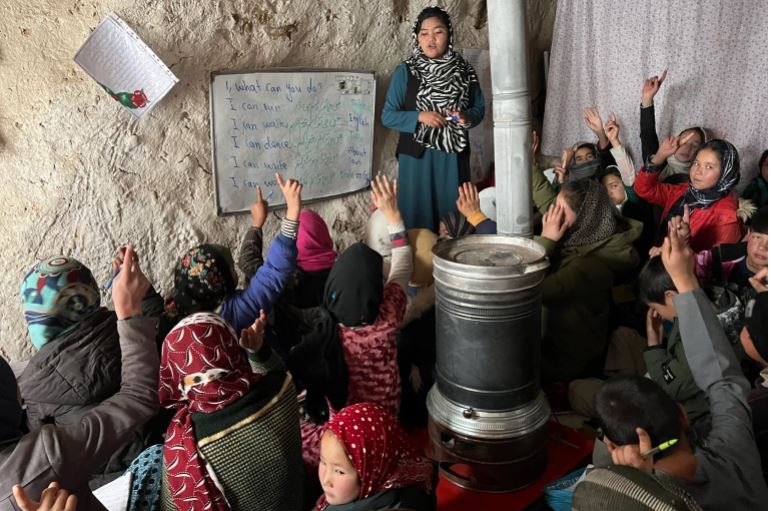A GIRLS SCHOOL IN BAMIYAN

By C K Nayak
The whole world watched Bamiyan with horror when its gigantic, tall statues of Buddha carved on the mountain cliffs were blasted to pieces in the nineties by the Talibans at the behest of Al Qaida. But even years later, at the slopes of the rugged mountains in a cave, runsa little-known small school mostly for girls managed by one daring young woman named Freshta Ahmadi. The schools still run months after the more horrific return of the prodigals albeit secretly. The little-known school is not far from where historic giant Buddha statues were blown up by the Taliban two decades ago. Incidentally, the Bamiyan mountains are dotted with caves where once Buddhist monks and nuns used to live. But now these caves are used by the improvised locals since these remain cool in harsh summer and hot in the biting winter of Afghanistan naturally.
The literacy rate in impoverished Bamiyan is very low, particularly among girls, some 25 percent of whom are literate, according to UN figures. Freshta is the only university graduate of her cave-village, having finished a midwifery course from Bamiyan university a few months ago. The imposition of sanctions and the sudden freezing of international aid, on which Afghanistan had been dependent for years, have hit hard particularly the people of Bamiyan, many of them from the Hazara minority who have historically suffered persecution. The worsening economic situation has also hit the village of the young teacher, who said most people are unemployed now. This has been the biggest change here, in the past months.
Amid such stark poverty and consequent illiteracy Freshta’s cave school remains still thriving but hidden. The school is for children who gather in the cave to learn basic English, Dari (local language) learning, mathematics and Quran. The education is totally free since the children come from very poor families, cannot afford private schools and government ones are far away. Their fathers are itinerant workers, farmers, or refugees from other poorer areas. Freshta has been running the cave school since 2012 with money donated by an Afghan charity and donations from visitors from other parts who come to see the remaining Buddhist-Islamist art and culture of Bamiyan. Freshta plans to find a job as a midwife as her father has struggled to make ends meet. She often also sells self-embroidered handkerchiefs in the local market to earn extra income.

Aaela (not her real name) is the mother of a 16-year-old boy of this cave school who cycles from another village that forms part of a unique landscape of snowy mountains and mud- brown valleys scattered with archaeological remains dating as far back as the first-century ancient Bakhtria. She hopes his son’s future will be better, thanks to the school. Before standing to recite by heart a love poem in Dari language, one of the girl students explained the importance of the school to her. Before coming to the school, she couldn’t read or introduce herself in English. Now she wants to become a pilot.
Freshta was scared after the Taliban armed group returned to power in August. The last time the Afghan group was in power between 1996-2001, it banned women from education and jobs. The school was lovely and colourful, but when the Taliban took over Bamiyan Freshta was very scared. She pulled down all the posters and drawings on the walls. She put all the colours and pens in a plastic bag and threw it in the nearby river, Freshta, in a coloured headscarf, said. Taliban fighters came thrice meanwhile but they were looking for a neighbour who used to work for the local police, but he’d already fled. They didn’t seem to know about the cave school.
Local authorities have been following the Taliban national leadership with respect to school and have so far turned a blind eye to realities such as Freshta’s school, which has survived in a cave, hidden away from the rebels who were dealing with more urgent economic issues and punishing the pro-West elements. The school has attracted pupils from other villages, too, and parents were aware that this is much more than a way of filling time.
But at the same time the circumstances don’t dampen the little ones’ ambition, however — the children, mostly girls, stand in turn at the whiteboard, complete a few exercises in front of their classmates, then reiterate their plans for a future as doctors, police officers or engineers and one even a pilot! Freshta is the lone teacher herself who hopes one day to become a doctor. There are about 50 children, most of them girls, who attend the informal school. The school runs for two hours daily six days a week in the morning offering an opportunity to the impoverished community at a time the country has been facing an unprecedented humanitarian crisis.
The issue of education for women has been a particularly controversial issue since the Taliban seized power a second time last August as US-led forces withdrew after 20 years of war, and the West-backed government of President Ashraf Ghani collapsed. Western governments and aid agencies have been pressing the Taliban to do more on human rights, education of girls and women empowerment. The Islamic Emirate of Afghanistan, the name of the Taliban’s government, still faces diplomatic isolation.
Source: Himalayan News Chronicle














टिप्पणीहरू